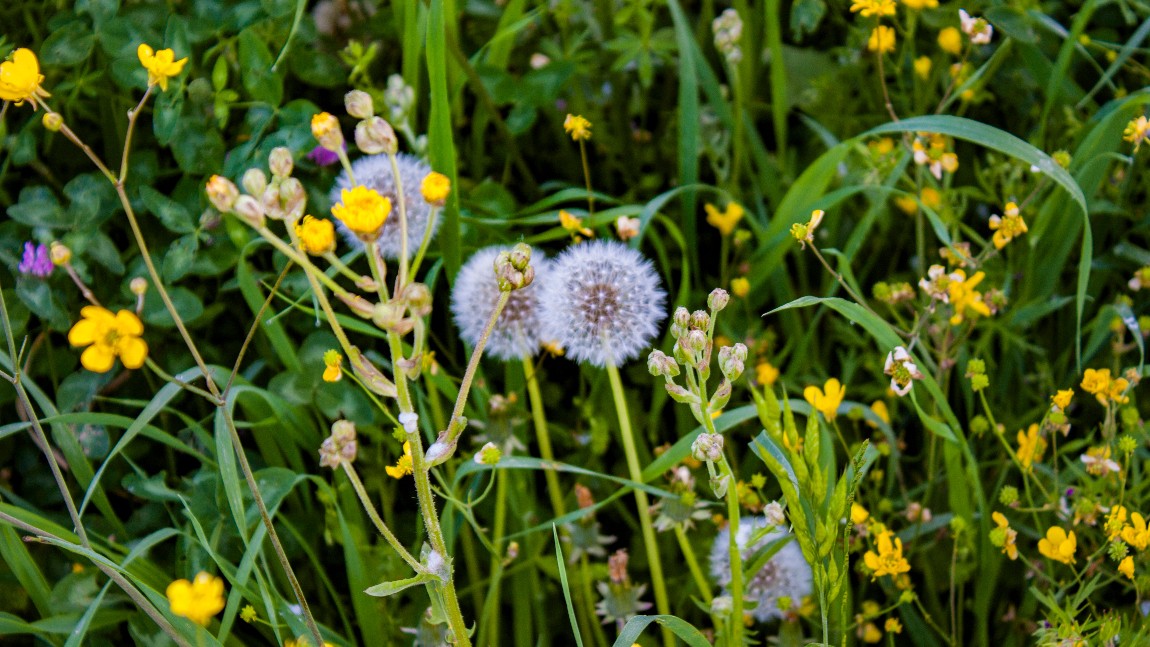PERMANENT MEADOWS AND PARMIGIANO REGGIANO CHEESE
Permanent meadows have always been an important element for the economy and landscape of the Parmigiano Reggiano production area.
As established by the Regulation drawn up by the Consortium of Parmigiano Reggiano cheese, the production of milk and its processing into cheese take place exclusively in the provinces of Parma, Reggio Emilia, Modena, Bologna to the left of the river Reno and Mantua to the right of the river Po.
The feeding of the cows that produce milk for the making of Parmigiano Reggiano cheese is based on the use of fodder from the typical production area: at least 75% of dry matter must be supplied by forage coming from the typical production area and at least 50% of dry matter must be supplied by forage produced on the farm land. The feeding of the cows complies with the norms of a strict specification that bans the use of silage and fermented feeds. Furthermore, in the daily feed, at least 50% of forage dry matter must be provided by hay.
It is first and foremost a microbiological characteristic that binds Parmigiano Reggiano cheese to its area of origin. Only raw milk produced in the area of origin is used to produce Parmigiano Reggiano cheese. It is a special milk, characterised by a unique and intense bacterial activity of the autochthonous microbial flora, and influenced by environmental factors.
The reason why Parmigiano Reggiano cheese cannot be “reproduced” outside its area of origin is bound to two fundamental and related factors: lactic flora and hay. As far as lactic flora is concerned, each area of the earth has its own particular percentage composition of the various bacterial strains present in the soil and among these also those belonging to the family of lactic bacteria. The haymaking process brings the forage in contact with the ground several times, resulting in its enrichment with the lactic flora naturally present on the meadows.In this way, hay becomes not only food but also a means of transporting lactic flora from the soil to the barn and from the barn to milk.
The forage deriving from the mowing of the mixed permanent meadows is the oldest resource for the feeding of dairy cows employed in the production of Parmigiano Reggiano cheese: first references to mixed permanent meadows date back to the XII Century and within the typical production area it is still today possible to find permanent meadows dating back to the XVIII Century.
The mixed permanent meadow is a spontaneous agrarian cultivation of herbaceous species not subject to rotation with other crops and for which agronomic plowing interventions are not foreseen for sowing.The maintenance of the turf and productivity is guaranteed through mowing, irrigation (on the plains), organic fertilization and spontaneous propagation of the species. In other words, it is a herbaceous cultivation that is left to spontaneous vegetation for a very long time, from a minimum of 10 years up to hundreds of years, which does not need subsequent artificial sowing, as the propagation of the species is guaranteed by natural mechanisms. It is thanks to the spontaneous propagation of the species that mixed permanent meadows present a high variety of plant essences.
From an analysis conducted from 2005 to 2007 by the Center for animal production research (CRPA) of Reggio Emilia, we know that the plant essences present in the mixed permanent meadows of the Bibbiano area are at least 63 and among the most frequently found species one can find: Daisy, Mouse-ear chickweed, Field bindweed, Dog’s foot grass, Cocksfoot grass, Hairy crabgrass, Tall fescue, Italian ryegrass, Perennial ryegrass, Alfalfa, Ribwort platain, Sorrel, Broadleaf dock, Setaria, Cheeckweed, Dandelion, Red clover, White clover, Bird’s eye, Thousand-leaf, Crested wheat-grass, Dog’s tooth grass, Eild garlic, Foxtail, Amaranth, Tall oat-grass, Artemisia, Shepherd’s purse, Fat-hen, Common chicory, Wild carrot, Getanium, Ground-Ivy, Purple deadnettle, Bird’s-foot trefoil, Ragged robin, Star of Betlem, Common knotgrass, Potentilla, Meadow clary, Campion, Sow thistles, Meadow salsify, Goat’s beard.
Mixed permanent meadows can be mowed and given to the cattle when they are still fresh and green, from April to November, or dried and kept in the stable for later use. As regards the production of hay, the quantities vary according to the seasonal trend and the cultivation care provided, reaching an average of 100-115 quintals per hectare obtainable from 3-4 cuts (5 cuts in particularly favorable seasons) of which the first, the most abundant, is carried out during the first half of May while the others are carried out every 35/40 days. The first cut provides forage rich in grasses, while legumes prevail in the summer months. Mixed permanent meadows therefore ensure excellent quality forage, capable of responding in a balanced way to the food needs of the livestock.
In ancient times, mixed permanent meadows constituted one of the main resources for the feeding of milking cows employed in the production of Parmigiano Reggiano cheese, so much so that the current “Feeding Regulation”, part of the “Disciplinary for the production of Parmigiano Reggiano cheese”, cites (art. 4) in the first place “fresh and hay fodder obtained from natural meadows, from mixed permanent meadows (…) “.
MIXED PERMANENT MEADOWS. AT THE ORIGIN OF THE SCENTS AND AROMAS OF PARMIGIANO REGGIANO CHEESE
It is not simply a matter of preserving and protecting an ancient tradition, today we know that the sensorial and nutritional characteristics of Parmigiano Reggiano cheese are the result of a complex and delicate balance of technological and environmental factors.
Among the latter, a fundamental role belongs to the feeding of dairy cows and in particular the presence or absence of meadow fodder, which have volatile components, such as vitamins and polyunsaturated fatty acids, capable of being transmitted to milk and which, in the case of some species, has also enzymes capable of modifying the characteristics of the cheese. We also know that the quantity of volatile components increases especially in the case of the administration of green fodder.
These differences, observable at a chemical level, can also be found at a sensory level, as the investigations carried out through special panel tests (groups trained for sensory assessments) have shown. Parmigiano Reggiano cheese obtained through a diet almost exclusively based on green or hay fodder from mixed permanent meadows has different sensorial and nutritional specificities compared to Parmigiano Reggiano cheese obtained through a diet based on other forages such as alfalfa. Parmigiano Reggiano cheese from mixed permanent meadows is characterized by a greater complexity and intensity of aromas and flavors and by a greater presence of unsaturated fats, Omega-3 and Conjugated Linoleic Acid, nutritional characteristics particularly beneficial for health.
The protection and safeguarding of mixed permanent meadows assumes strategic importance for the agronomic reasons linked to the Parmigiano Reggiano supply chain above described as well as for naturalistic-environmental reasons. Mixed permanent meadows, in fact, characterized by the absence of repeated mechanical processing and by the non-use of pesticides for production, represent habitats capable of hosting rare or endangered species of flora and fauna.
Do you want to discover the origin of the variety of scents and aromas of Parmigiano Reggiano?
Visit the production companies with Artemilia and discover the mixed permanent meadows that are so important to Parmigiano Reggiano cheese!

